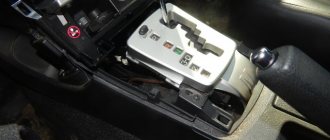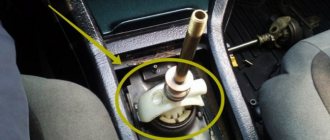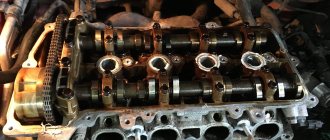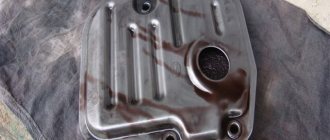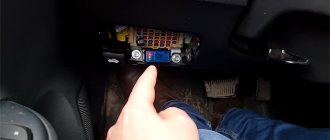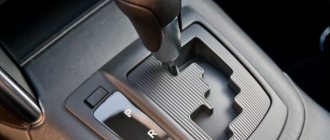- home
- car transmission
- …
Now there are a lot of myths about reverse gear at speed. Like, if you turn it on at speed, then that’s it, the gearbox will be destroyed and it will die for a long time. And the automatic transmission will immediately turn into a pile of metal and you can immediately throw it away! Is this really so and what will happen if you try to perform these maneuvers at speed? Read and watch the video at the end, it will definitely be interesting...
For experienced drivers, this question does not cause any emotions, all because they know that nothing bad can happen in modern gearboxes. But for beginners, if they try or engage reverse gear at speed, they immediately panic (especially if it is an automatic transmission). In general, I won’t beat around the bush, I’ll break it down into two main transmissions.
Mechanics (manual transmission)
In order to understand that you will not kill your manual transmission, you just need to try to engage reverse gear while driving.
There will simply be a deafening crunch, and the transmission will not want to engage. No matter how many times you try to install it.
The thing is that the lever on the mechanics is rigidly connected to the gear shift fork(s). When moving forward, the shafts (primary and secondary, possibly intermediate) rotate in a certain direction. To engage reverse, you need to make them rotate in another, absolutely opposite direction (which is possible), BUT it’s very difficult! Only after a complete stop, it is easy and simple to do this and they will go in a different direction.
Another point is that the reverse gear does not have a synchronizer (in fact, it does not need one), and therefore the gear is engaged only from a standing position. Therefore, a wild crunch will be heard.
Engaging reverse gear at speed: risks and possible consequences
So, on manual transmissions, the gear shift scheme is implemented quite simply, and the inclusion of reverse gear on most modern cars has additional “protection”, which requires the need to lift a separate lock.
On cars with automatic transmission, the selector moves in different modes, and the lever cannot be moved without pressing the brake pedal. While driving, switching automatic transmission modes also requires pressing a separate button on the lever.
However, some drivers, for one reason or another, still manage to accidentally engage reverse gear R in both manual and automatic transmissions, after which many concerns arise regarding the possible consequences. Let's figure it out.
At the same time, other car enthusiasts do not share the panicky mood, as they firmly believe that everything is provided for in modern boxes and nothing bad will happen. Let's see who is right.
- First of all, the manual transmission mechanics will not allow you to simply engage reverse gear while driving. If you try to do this, you may hear a strong cracking sound, crunching, etc. However, this sound does not mean in any way that a critical failure immediately occurred in the box.
In a nutshell, the gearshift lever on a manual transmission has a rigid connection with the gear shift fork(s). Also, when driving forward, the gearbox shafts (primary, secondary, intermediate) rotate in one direction. After engaging reverse gear, the shafts should rotate in the other direction.
On a completely immobilized car, reverse gear is easily engaged, however, taking into account the design features, when moving forward, it is extremely difficult to “stick” the reverse gear, although it is possible.
Also, the reverse gear on most cars does not have a synchronizer (it is not necessary), since this gear is only engaged when the car is completely stopped. If the car is moving, the gear will often not engage, but instead there will be a strong crunching sound.
If we consider the issue in more detail, in a manual transmission, when changing gears, the rotation speed of the coupling, which is equal to the rotation speed of the driven shaft, is synchronized with the rotation speed of the gear.
This is what prevents you from engaging reverse gear when moving forward. There will be a crunch, but the clutch will not engage, that is, the gear will not engage. If you try to engage the rear wheel several times while driving, you can damage the synchronizer, clutch or gear.
- Now let's move on to the automatic transmission. Let us immediately note that in this case, engaging reverse gear will not mean that a critical breakdown has occurred. First of all, there are several types of machines that are controlled mechanically and electronically.
Old automatic transmissions have cable control. To protect the box, a lock is activated, and a prerequisite for removing it when reverse gear is engaged (mode “R”) is to press the brake pedal. In other words, you won’t be able to engage the rear without pressing the brake.
It turns out that even if the driver engages the rear automatic transmission at speed, the electronic unit, which receives information from a group of sensors (speed sensor, TPS, etc.), will consider such inclusion a failure or error.
Simply put, the box will switch to neutral “N”, and the “R” switch may light up on the panel. It turns out that the reverse gear simply will not engage, the car will roll in neutral. The only thing is, if this happens, in this case you need to proceed correctly.
- If the driver notices that the automatic transmission is in “R” mode, there is no need to press the gas pedal. Also, do not rush to switch the selector to “D” mode, which can also lead to failures and errors.
Automatic (automatic transmission)
Nothing bad will happen here either. You shouldn’t believe the “miracle masters” at the service station who tell you that everything, FUCKING, is gone! Once I engaged reverse gear at speed, even if it was not high, and the automatic transmission was replaced. Do you believe in this yourself? If in fact everything was exactly like this, then it would be the favorite box of all workshops, but ordinary drivers would hate it, because the repair is simply “GOLDEN”.
I'll tell you how it is. Now it is worth distinguishing between two types of torque converter machines:
- Old type . They often have three or four gears (rarely five). They change gears using a special cable. Therefore, in order not to damage the structure while moving, the designers came up with the idea of blocking the lever when you want to turn on “R”. You simply cannot do this, thereby protecting the transmission from destruction
- New type . There is more automation and electronics here; often the lever is not rigidly tied to the automatic transmission, and all the orders that you give (with its help) are carried out by special electric drives. Thus, at speed, if you put the rear in, the transmission will indicate this as an incorrect algorithm and will begin to protect itself from such actions by going into neutral mode (although “R” will light up on the panel). AND NOTHING WILL HAPPEN. You'll just roll and that's it.
However, if you notice that you have stuck the rear one, on a modern machine you need to get out of this situation correctly.
Engaging reverse gear while driving
Many car enthusiasts and just ordinary observers of the automotive world are sometimes interested in the question - what will happen if you engage reverse gear while moving forward at speed?
First you need to decide whether you are more interested in a car with which gearbox , automatic or simple manual.
Let's try to understand the principle of operation of a manual gearbox . Even modern manual cars do not have any special mechanisms to protect against reverse gear engagement. Yes, most of them have switches in the form of rings or buttons, without pressing which you will not be able to accidentally engage reverse gear. But what if you need to do this on purpose?
In a conventional manual transmission, gears are changed by depressing the clutch pedal, moving the lever to the desired gear, and then engaging the clutch by releasing the pedal.
It is important to know how reverse gear works in such a box. It is inverse to the first, which means it rotates in the other direction.
Let's move directly to the essence of the question given to us - namely, if you accelerate and try to move the gearbox lever to reverse gear, the first thing you will hear is the crunching and crackling of gears that cannot engage, since even with the clutch disengaged, the gearbox continues to move inertia to rotate forward.
After some time, the shafts will stop and engage with the reverse gear.
At this point, we can say that reverse gear is engaged, and as soon as you begin to release the clutch pedal, the engine will begin to stall, the gearbox will experience heavy loads, and the clutch will wear out. In this situation, if you press the accelerator pedal more, the engine will try to spin the drive wheels in the opposite direction.
What does it mean? This means that at speed, while the car is moving forward, the drive wheels will go in a so-called “skid” - they will stop rotating and begin to slide along the road surface. As soon as the speed drops due to such “braking,” the wheels will begin to spin in the opposite direction, and the car will inevitably fall into an uncontrollable skid. At the same time, the gearbox will still experience severe loads.
What to do, how to behave
Actually, there are no complex algorithms, but there are a few things to remember:
- If you notice that “R” is on, do not accelerate
- Don’t switch to “D” right away, it’s fraught!
- You need to stop and after a complete stop, switch to “DRIVE”
Why do you need to do it this way, and not immediately transfer from “R” to “D”? WE have already realized that in modern cars, when such an error occurs, neutral is switched on, in which you can roll, but you should not turn on DRIVE from it
It's all about the torque converter (now there will be exaggerated information to simply understand the principle), it has two impellers: the first is connected to the engine, the second to the transmission.
When you move forward, then oil pressure is transmitted from one to the other, that is, torque . And at speed they rotate the same. As soon as you turn on “N” (or in our case “R”), the machine disengages the connection, the impellers begin to rotate at different speeds. If you apply pressure sharply (that is, turn on “D”), it can damage parts of these turbines, so you must first level it (stop), then move off (I think I explained it clearly).
Now we are watching the video version
I think many people will ask me a question about the variator and the robot - how is it going with them? Everything is simple here - you won’t be able to engage reverse gear at speed at all, similar to the old automatic transmission. The thing is that they have such designs that prevent the wrong actions of a novice driver.
I’ll end with this, I think it was useful, read our AUTOBLOG, subscribe to the channel.
Similar news
- Robot (manual transmission) – robotic gearbox. What it is? ...
- Automatic transmission clutches. What are they, how do they work and why do they burn?
- Automatic transmission adaptation reset. We will consider KIA and Hyundai
Press until crisp
There are many different transmissions on the market today. In addition to the classic manual transmissions of the two-shaft system, there are hydromechanical automatic transmissions, continuously variable transmissions and modern preselective robots with two clutches. Each of these boxes has its own weak points. We will consider only the most common of them: manual and automatic transmissions.
On many manual five-speed gearboxes, the reverse position is set after the highest gear. Therefore, almost every driver has at one time or another misplaced the lever past the required grooves and ended up in reverse at speed. This usually happens on old units with a worn-out rocker without clamps. When trying to switch from “fifth” to “fourth” this incident happens. True, there is such a crunch and crack that the hand instinctively throws the selector back to the neutral position. It seems that a little more and the box will fall into pieces.
But in reality, it is very difficult to engage reverse at high speed. The fact is that the manual transmission is not structurally adapted to this. There are input, intermediate and output shafts. Engagement and transmission of torque is realized using toothed gears. And if the shaft with gears rotates at high speed in one direction, then inserting another gear into it, responsible for reverse gear, is incredibly difficult. The teeth will grind, wear out, even crumble, but there will be no full engagement. To do this, it is necessary to stop the rotation of the output shaft and only then move the lever to R mode. This applies to manual transmissions without synchronizers in reverse and protective locking devices.
Question answer
Is it possible to use engine braking on cars with an automatic transmission? Some boxes are now equipped with idle speed synchronizers. This clever device makes it easier for the gears to engage. But even with synchronizers, the boxes almost never activate reverse by accident. Locks are placed on them, which need to be pushed when the selector is moved to R.
However, there are a lot of videos on the Internet showing that such inclusion is possible. For example, on a Ford pickup truck with a Japanese manual transmission, you can see how the wheels begin to rotate backwards, smoke comes from the tires and the rear skids until the car stops and rolls back. For such a spectacular trick, you need to have remarkable strength and specially prepare the transmission for the performance by installing gears with ground teeth. Then there is a chance that they will get caught.
But if this technique is performed on the vast majority of passenger cars, then you can break the link, crumble the gears or bend the rods, without ever forcing the box to turn the wheels in the opposite direction. After this, the transmissions will stop turning on altogether. You'll have to go to a service station.
Reverse gear does not engage: common breakdowns
Thus, if it is difficult or completely impossible to engage reverse gear, such a malfunction is a common problem that can be encountered in various vehicles when changing gears.
In addition, both manual and automatic transmissions do not engage reverse gear (reverse speed has disappeared in the automatic transmission). Of course, in such a situation it is important to identify the cause of the malfunction and eliminate the malfunction, because normal operation of a car without reverse gear is simply impossible (vehicles practically without reverse gear). Let's analyze this.
- Let's start with the manual transmission and look at why a manual transmission won't engage reverse. Firstly, in “mechanics” the reverse gear fails much more often than in an automatic transmission. As a rule, the first signs of a breakdown are a grinding, crackling or crunching sound in the reverse gear when turning it on, reverse gear is difficult to engage, the gear can be changed in several steps, etc.
The main disadvantages include the following:
- The clutch is not fully engaged. It is known that the clutch connects the engine and the gearbox; when changing gears, the driver must press the clutch pedal and “disconnect” the internal combustion engine from the gearbox. When the pedal is engaged, the clutch is "locked" and torque is transferred back to the wheels.
If the clutch is not fully disengaged, the transmission will not be completely disconnected from the engine. This leads to the fact that all gears are difficult to engage. At the same time, in many cars, first and reverse gears do not have synchronizers. As a result, clutch problems are most noticeable when engaging reverse gear.
In this situation, you may hear a clicking and rattling sound when you try to shift gears. To eliminate the breakdown, special attention should be paid to the clutch (condition of the clutch disc, basket, release bearing, etc.). You should also check the clutch adjustments, pedal quality, etc.
- The oil level in the gearbox is low or the gear oil has lost its properties. As practice shows, there is a common misconception among motorists that the gearbox is filled with oil throughout the entire service life of the car. In fact, even the highest quality gear oil becomes unusable after a maximum mileage of 100,000 km. km. And this is subject to economical use.
If the car is operated in difficult conditions (city driving, fast pace, constant changes in speed “up” and “down”, short routes, temperature changes, etc.), the gearbox oil should be changed every 50-60 minutes. thousand. km. This is due to the fact that the properties of the liquid change in the oil, additives enter, impurities accumulate, products of mechanical wear of the box and various deposits.
- The gearbox rocker arms require adjustment, the gearbox drive rods or drive levers are deformed. Often, after diagnosing the condition of the rocker arm, it becomes clear why reverse gear does not engage in Zhiguli and various foreign-made cars (especially old ones or with high mileage). Owners of front-wheel drive VAZ cars know that a poorly adjusted rocker arm is the reason why reverse gear does not engage or disengage.
The way out of this situation is to adjust the gearbox rocker arm, which allows you to improve the response to gear shifting and obtain the desired smoothness. Also, in some cases, owners remove the mechanism and install a switch flap, but in this case one should be prepared for the need for more careful adjustment. For transmission and drive mountings, these components should be inspected for possible damage or cracks and then replaced.
- Design features of the gear. Often, reverse and first gears in cheap cars do not have synchronizers. The absence of these elements, on the one hand, simplifies the design of the box, but on the other hand, difficulties arise with engaging reverse gear and first gear.
